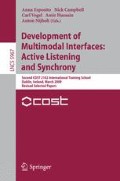Abstract
The proposed paper describes an approach that was used to influence conversational agent Greta’s mental state. The beginning this paper introduces the problem of conversational agents, especially in the listener role. The listener’s backchannels also influence its mental state. The simple agent state manager was developed to impact Greta’s internal state. After describing this manager, we present an overview of evaluation experiments carried out to obtain information about agent state manager functionality, as well as the impact of the mental state changes on the overall interaction.
Access this chapter
Tax calculation will be finalised at checkout
Purchases are for personal use only
Preview
Unable to display preview. Download preview PDF.
References
Nass, C.I., et al.: Computers are social actors: a review of current research, pp. 137–162 (1997)
Ball, G., Breese, J.: Emotion and personality in a conversational agent. Embodied Conversational Characters. MIT Press, Cambridge (2000)
Cassell, J., Bickmcre, T., Campbell, L.: Designing Embodied Conversational Agents. Embodied Conversational Agents (2000)
Pelachaud, C.: Multimodal expressive embodied conversational agents. In: MULTIMEDIA 2005: Proceedings of the 13th annual ACM international conference on Multimedia, pp. 683–689. ACM, New York (2005)
Maatman, R.M., Gratch, J., Marsella, S.: Natural behavior of a listening agent. In: 5th International Conference on Interactive Virtual Agents, Kos, Greece (2005)
eNTERFACE Summer School web page, http://enterface08.limsi.fr/ (June 10, 2009)
Al Moubayed, S., et al.: Multimodal Feedback from Robots and Agents in a Storytelling Experiment. In: Project 7: Final Project Report, eNTERFACE 2008, Paris, France, August 4-29 (2008)
Yngve, V.: On getting a word in edgewise. Papers from the Sixth Regional Meeting of the Chicago Linguistic Society, pp. 567–577 (1970)
Allwood, J., et al.: On the semantics and pragmatics of linguistic feedback. Semantics (1993)
Kopp, S., et al.: Modeling embodied feedback with virtual humans. In: Wachsmuth, I., Knoblich, G. (eds.) ZiF Research Group International Workshop. LNCS (LNAI), vol. 4930, pp. 18–37. Springer, Heidelberg (2008)
Van baaren, R.B. (ed.): Mimicry: a social perspective (February 10, 2003), http://webdoc.ubn.kun.nl/mono/b/baarenrvan/mimi.pdf
Chartrand, T., Bargh, J.: The Chameleon Effect: The Perception-Behavior Link and Social Interaction. Personality and Social Psychology 76, 893–910 (1999)
Cassell, J., et al.: Non-verbal cues for discourse structure. In: Proceedings of the 39th Annual Meeting on Association for Computational Linguistics, Association for Computational Linguistics Morristown, NJ, USA, pp. 114–123 (2001)
Thórisson, K.R., et al.: Whiteboards: Scheduling blackboards for semantic routing of messages & streams. In: AAAI 2005 Workshop on Modular Construction of Human-Like Intelligence, pp. 8–15 (2005)
Vilhjálmsson, H.H., et al.: The Behavior Markup Language: Recent developments and challenges. In: Pelachaud, C., Martin, J.-C., André, E., Chollet, G., Karpouzis, K., Pelé, D. (eds.) IVA 2007. LNCS (LNAI), vol. 4722, pp. 99–111. Springer, Heidelberg (2007)
Heylen, D., et al.: Why conversational agents do what they do? Functional representations for generating conversational agent behavior. In: The first Functional Markup Language workshop. The Seventh International Conference on Autonomous Agents and Multiagent Systems Estoril, Portugal (2008)
Ward, N., Tsukahara, W.: Prosodic features which cue back-channel responses in english and japanese. Journal of Pragmatics 23, 1177–1207 (2000)
Bevacqua, E., et al.: Facial feedback signals for ECAs. In: AISB 2007 Annual convention, workshop “Mindful Environments”, Newcastle upon Tyne, UK, pp. 147–153 (2007)
Lakin, J.L., et al.: Chameleon effect as social glue: Evidence for the evolutionary significance of nonconsious mimicry. Nonverbal Behavior 27(3), 145–162 (2003)
Bevacqua, et al: A listening agent exhibiting variable behaviour. In: IVA 2008. LNCS (LNAI), vol. IVA 2008, pp. 262–269. Springer, Heidelberg (2008)
Pollak, P., Cernocky, J., Boudy, J., Choukri, K., Rusko, M., Trnka, M., et al.: SpeechDat(E) Eastern European Telephone Speech Databases. In: Proc. LREC 2000 Satellite workshop XLDB - Very large Telephone Speech Databases, Athens, Greece, May 2000, pp. 20–25 (2000)
Lindberg, B., Johansen, F.T., Warakagoda, N., Lehtinen, G., Kačič, Z., Žgank, A., Elenius, K., Salvi, G.: A noise robust multilingual reference recognizer based on SpeechDat (II). In: Proc. ICSLP 2000, Beijing, China (2000)
Heylen, D., et al.: Searching for prototypical facial feedback signals. In: Pelachaud, C., Martin, J.-C., André, E., Chollet, G., Karpouzis, K., Pelé, D. (eds.) IVA 2007. LNCS (LNAI), vol. 4722, pp. 147–153. Springer, Heidelberg (2007)
Reeves, B., Nass, C.: The media equation: How people treat computers, television and new media like real people and places (1996)
Young, S.: ATK: An application Toolkit for HTK, version 1.6. Cambridge University, Cambridge (2007)
Sacks, H., Schegloff, E.A., Jefferson, G.: A simplest systematics for the organization of turn taking for conversation. Language 50(4), 696–735 (1974)
Author information
Authors and Affiliations
Editor information
Editors and Affiliations
Rights and permissions
Copyright information
© 2010 Springer-Verlag Berlin Heidelberg
About this chapter
Cite this chapter
Ondáš, S., Bevacqua, E., Juhár, J., Demeter, P. (2010). Towards Influencing of the Conversational Agent Mental State in the Task of Active Listening. In: Esposito, A., Campbell, N., Vogel, C., Hussain, A., Nijholt, A. (eds) Development of Multimodal Interfaces: Active Listening and Synchrony. Lecture Notes in Computer Science, vol 5967. Springer, Berlin, Heidelberg. https://doi.org/10.1007/978-3-642-12397-9_9
Download citation
DOI: https://doi.org/10.1007/978-3-642-12397-9_9
Publisher Name: Springer, Berlin, Heidelberg
Print ISBN: 978-3-642-12396-2
Online ISBN: 978-3-642-12397-9
eBook Packages: Computer ScienceComputer Science (R0)

